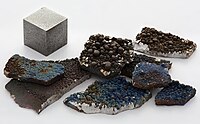
Photo from wikipedia
Limited comprehension of the reaction mechanism has hindered the development of catalysts for CO2 reduction reactions (CO2 RR). Here, the bimetallic AgCu nanocatalyst platform is employed to understand the effect… Click to show full abstract
Limited comprehension of the reaction mechanism has hindered the development of catalysts for CO2 reduction reactions (CO2 RR). Here, the bimetallic AgCu nanocatalyst platform is employed to understand the effect of the electronic structure of catalysts on the selectivity and activity for CO2 electroreduction to CO. The atomic arrangement and electronic state structure vary with the atomic ratio of Ag and Cu, enabling tunable d-band centers to optimize the binding strength of key intermediates. Density functional theory calculations confirm that the variation of Cu content greatly affects the free energy of *COOH, *CO (intermediate of CO), and *H (intermediates of H2 ), which leads to the change of the rate-determining step. Specifically, Ag96 Cu4 reduces the free energy of the formation of *COOH while maintaining a relatively high theoretical overpotential for hydrogen evolution reaction(HER), thus achieving the best CO selectivity. While Ag70 Cu30 shows relatively low formation energy of both *COOH and *H, the compromised thermodynamic barrier and product selectivity allows Ag70 Cu30 the best CO partial current density. This study realizes the regulation of the selectivity and activity of electrocatalytic CO2 to CO, which provides a promising way to improve the intrinsic performance of CO2 RR on bimetallic AgCu.
Journal Title: Small
Year Published: 2023
Link to full text (if available)
Share on Social Media: Sign Up to like & get
recommendations!